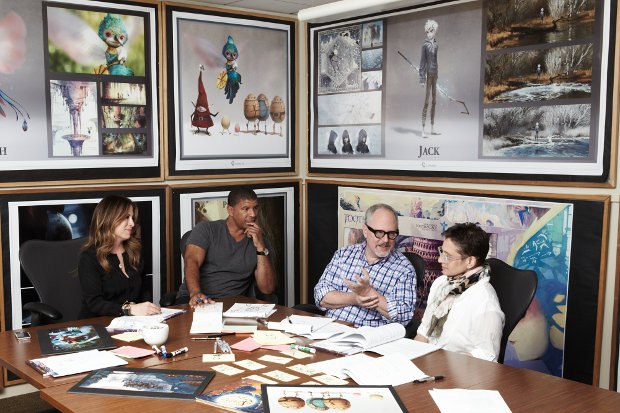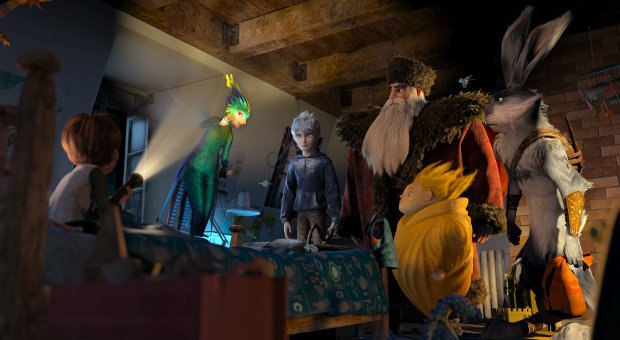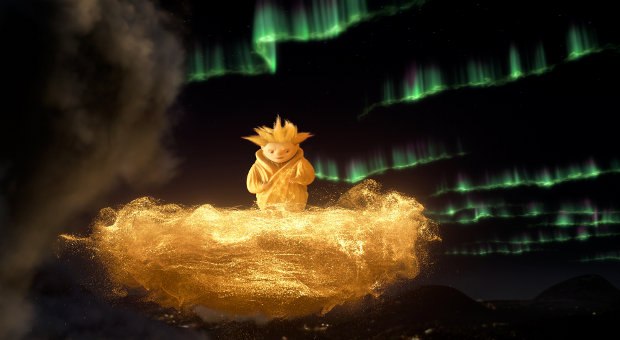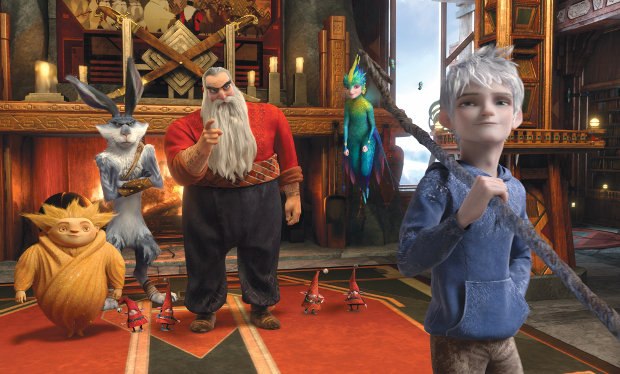William Joyce and Peter Ramsey discuss the use of enchantment and new animation breakthroughs in the latest DreamWorks Oscar contender.
Give William Joyce credit for bringing together Santa (Alec Baldwin), the Easter Bunny (Hugh Jackman), Sandman, the Tooth Fairy (Isla Fisher), Jack Frost (Chris Pine), and The Boogeyman (Jude Law) in a whole new light in Rise of the Guardians, and first-time director Peter Ramsey (a story artist that's worked in both animation and live action) and the DreamWorks Animation team for embracing pure enchantment. The Guardians is The Avengers of fairy tales without a trace of post-modern cynicism. Even executive producer Guillermo Del Toro was more touched than usual. He found it romantic at its core.
"We all had an image of what these guys should look like but could never articulate it, so my job was to guide that place we'd almost been thinking of," Joyce explains. The celebrated children's book author and illustrator/designer, who won the Oscar this year for his animated short, The Fantastic Flying Books of Mr. Morris Lessmore, was first inspired years ago when his daughter asked him if Santa and the Easter Bunny knew one another. That got Joyce thinking about the nature of fairy tales and enchantment and eventually led to his Guardians book series and the DreamWorks animated feature, which have been developed simultaneously. Sadly, Mary Katherine, passed away two years ago of a brain tumor at the age of 18, so the project has become even more meaningful to Joyce.

(From l-r) Producer Christine Steinberg, Director Peter Ramsey, Executive Producer William Joyce and Producer Nancy Bernstein.
Indeed, when I bring up the beautiful opening scene in which Jack Frost rises out of a frozen lake and is reborn, I ask Joyce if he's an angel or not. Joyce says he prefers to think of Jack as being rescued by the Man in the Moon from the brink of death. "Sometimes I'm not even sure of the literal meaning of certain things. To me, it's better to leave it up to interpretation."
And when it came to balancing tone, they all had an internal sense of how far to push it. "We got it right to that Wicked Witch of the West place where it's deliciously terrifying and you don't want to take your eyes off of it. And it's evil in a seductive way rather than, 'Oh, my god! I don't want to look!'

Joyce was first inspired years ago when his daughter asked him if Santa and the Easter Bunny knew one another.
"I actually directed a scene early on that pushed it way too far. It was a prologue that was a battle between the Man in the Moon and Pitch [the Boogeyman]. It was so much fun doing it -- epic stuff -- but Pitch has this horrifying skull-like death head that's a zillion times worse than what's in the movie. As soon as we saw it, we said that's too far."
However, Joyce is proudest of the Sandman, or Sandy, as he's called in the movie. He's a mute, badass Buddhist-type of character naturally inspired by silent comedians. "Of all the revisionist takes on these guys, I thought we had the most room with Sandy to play around in his sandbox. Early on, they asked me to do inspiration reels for each character and I saw Sandy as mute and so we looked at both Laurel and Hardy with the girth of Hardy and the sweetness of Laurel and then Harpo Marx, who always had this mad sweetness about him. And Sandy floats about as if he's filled with helium."
For Ramsey, the most inviting aspect of the movie was the notion that children's belief in these beloved icons is so strong, so integral, that they can't exist without it. So he merely upped the superhero quotient. "We streamlined a lot of what Bill Joyce had done," Ramsey suggests. "He has this beautiful, ornate, retro style drawing from Arthur Rackham, Maxfield Parrish, and N.C. Wyeth and for animation you have to pare away all of the details, so, number one, you can render all of the details, and, number two, so you can move them through space elegantly. That was job one but we did the best we could to retain the flavor of his characters."
Human animation for DreamWorks reaches new heights with Guardians, particularly the softness of Jack's skin and the subsurface scattering. They studied the rapid prototyped Legacy models made of resin and through reverse engineering were able to achieve a new degree of subtlety. "It was built on the idea of actual, physical models of how high light passes through the layers of skin to create a slight translucency," Ramsey adds. "That was something that had never been done before at DreamWorks but our head of visual effects, David Prescott, brought that technology to the film with those shaders."
The sand of Sandman and Pitch was the biggest breakthrough and biggest expenditure. There's so much of it n the movie and it becomes its own character, split into two variations, golden and black: the dreams and the nightmares. Prescott and effects lead Stephen Wood worked for nearly a year with the team developing this system. It's one of the most ambitious point render effects they've done. The sand emits light and made up of wondrous design shapes, filigrees and swirls. They were able to intricately design where and when they wanted animated shapes to happen within a stream. Curiously, by running the stream backwards they accidentally stumbled upon the best possible reversal effect for Pitch's black sand, which is coarser in its makeup.
For Ramsey, it was more of an aesthetic breakthrough than a technical one. "It does two things actually. There's the lyrical streaming and as it's forming characters it will make these, whimsical, stylized shapes. There were some curlicues that it does really well and the way that the strands fold back into each other is a really graceful and elegant separation."
"To me the best art, the best movies, the best books are the ones you can go to over and over again and you grow with the story," Joyce concludes. Both Joyce and Ramsey want to grow the Guardians into a franchise. Up next: perhaps the Man in the Moon.
--
Bill Desowitz is former senior editor of AWN and VFXWorld, the owner of Immersed in Movies (www.billdesowitz.com), a columnist for Thompson on Hollywood at Indiewire and author of James Bond Unmasked (www.jamesbondunmasked.com), which chronicles the 50-year evolution of 007 on screen, featuring interviews with all six actors.










